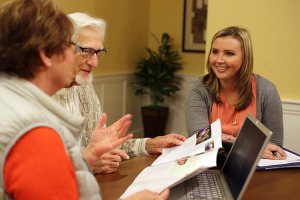 Three Different Clients – Three Different Solutions – Client Success Stories
Three Different Clients – Three Different Solutions – Client Success Stories
While each situation is unique, one constant thread connects our clients: The care they received was clearly centered on what each person needed.
Resistance to Care
Rose is an 80-year-old woman who lives alone. Her adult child, Steve, lives in the area and is concerned at her reluctance to accept help. Rose sits in her den with three weeks of newspapers on the couch. The television is on, but the sound doesn’t work. Three tea-stained cups are scattered around the room. When asked if she’s had lunch, she says, ‘yes’ . . . but a walk through the kitchen reveals no recent dirty dishes or food-related trash. Her clothes are soiled and her hair is not shampooed. She walks without difficulty, but repeats the same story about her husband three times (she says he’s at work). The first time she tells it, the story makes sense and you’re not sure if it’s real. She says, loudly and clearly, that every one of “those people” who came to help had to be fired.
An Eldercare Services’ Care Manager visited Rose, talking with and listening to her. The Care Manager assessed the situation and then talked with Rose’s son who said that the previous care provider had recommended a nursing home. The Care Manager understood why Rose was resisting care and believed the most important first step was to establish a basis of trust. A caregiver, who was mentored in the “Eldercare Services Way” by the Professional Geriatric Care Manager, was hired to help Rose by following the Care Manager’s customized care plan. Building trust and raising Rose’s comfort level allowed the caregiver little by little to provide more care and services.
Within 6 months, the caregiver was working 6 to 8 hours a day, providing a safe, clean environment and helping with her personal care. Rose was able to continue to live at home. Her son was satisfied that she was getting the care she needed. Steve was finally able to enjoy his visits with his mom without the worries.
Memory Loss
We found her strapped to a bed in a nursing facility, following a series of small strokes.
She had some short-term memory loss and impaired vision, but could walk on her own. She was anxious to return to her home – a single story 2-bedroom apartment in poor condition, located in a retirement community. Jessie was a widow, with no children and only one relative, a niece in Florida. She had established a Trust with a San Francisco bank, but they were reluctant to make quality of life decisions for her. Her doctor was adamant that she receive 24-hour care.
Eldercare Services assessed Jessie and, working with her doctor, determined she wouldn’t need to be in a skilled nursing facility if she had proper support at home. We obtained Durable Power of Attorney and made arrangements for Jessie to return home. Since nutrition and medications were a concern, we worked out a plan to provide the care she needed — providing attendants supervised by Professional Geriatric Care Managers.
Once home, Jessie became more mobile. Her lively “spirit” returned. Her dignity and self-respect were restored — she was treated as still in charge of her own home. When the apartment was re-carpeted and painted (with her Care Manager’s support), she was proud of her home and invited others to visit.
Jessie started participating in a social day care program, meeting and interacting with her peers two afternoons a week. She also began to enjoy walks at a local indoor mall with her companion. For evening entertainment, Eldercare Services helped her get a VCR and the cable channels she desired.
Even though dementia and more small strokes prevented Jessie from performing many daily activities, she was extremely happy and content at home. Her physician and our professional staff provided additional care as her needs changed. Jessie lived happily at home for 5 years under the care of Eldercare Services. Her niece was grateful for the quality of life she enjoyed. Jessie spent the last years of her life where she deserved and wanted to be – at home.
Caring Across the Miles
George, an 85-year-old man, lived in a California retirement community and cared for his bed-ridden wife, Mildred, who had suffered a stroke. Their family members lived in Kansas.
Both George and Mildred were admitted to a nursing home after George fell and broke his hip. We were called by their daughter to help George and Mildred return to their retirement community. At that time, the family was paying for both the nursing home and 24 hour private duty staffing.
George was upset and depressed at the nursing home and determined to get home. Mildred was doing well at the nursing home — her needs were being met and she seemed happy. George was devoted to his wife and wanted her to be with him.
An Eldercare Services Care Manager visited the nursing home and concluded that returning them both home was not in their best interest. The Care Manager understood George’s devotion to Mildred and knew he’d only be satisfied at home . . . but was aware of the different care each of them needed. So she looked for a creative, cost-effective solution that would meet their individual and combined needs.
She arranged for George to return home, established 8-hour care and helped him visit his wife every day. This helped continue their bond without compromising care (cost effectively). At the same time, the Care Manager advocated for Mildred’s quality of care within the facility. She was able obtain a telephone for and create a schedule for George’s visits. When George got sick and frail, Eldercare Services continued to support him and his wife.
After George died, Mildred’s family wanted to care for her in Kansas. We worked with the nursing home to move her and arranged for an air transport (medical care flight) to get her across the country.
During their aging journey, Eldercare Services was respectful of George and Mildred’s relationship. We helped find a solution that suited them both while providing the care each needed. Eventually, the situation changed and Mildred’s family wanted to be more involved. So, Eldercare Services helped move her to Kansas. By doing this, we were able to keep family members connected using creative, cost-effective solutions that best met everyone’s needs. This allowed George, Mildred and the family to enjoy the time they had to spend . . . together.

